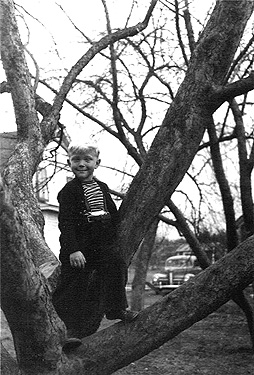

|
My earliest memories are when I was 3-4 years old, when we lived in Holyoak, Massachusetts, where my brother Dan was born. I remember an outdoor swing, where 2- 3 people could sit in each of the opposing seats. Haven't seen one like this since. Also, it was here I developed a lasting fondness for climbing trees. And I remember my first Christmas.
I recall much more after our move to Pullman, Washington. Dad was teaching ROTC at WSU. We first lived in a tiny house close to town. I seem to recall a wood cooking stove. And the thrill of digging through boxes of shredded wheat to get to the prizes hidden between the big biscuits. Also remember a viaduct, with big concrete lions guarding the entrances. I went to kindergarten in a big grey-stone church. All I remember of this was nap time ... sliding around the floor on my blanket. It was here I got my first bike, a little red one, and I remember the trauma of learning to ride. (My sister Linda had a bigger blue one.). While living there, Dad and his Uncle Paul built a new house up on the hill in an area that was being newly developed. We were the first house there, out in the middle of a field, with a great pastoral view of an adjacent farm. As more houses were built, we finally got some neighbor kids to play with.
When I started first grade, living in the new house, we rode our bikes down to the school. I remember the "down" part clearly, as I once had an unfortunate high-speed meeting with the side of a pickup truck at the bottom of the hill. Times were good. No one was worried at all about sending kids off to school on their own, girls or boys. One of my best summer-time memories, was walking to the swimming pool. It was close to town, and the route took us down many flights of rickety wooden stairs. Always an adventure. The new house had a full basement. On one end of the utility room was a wood pile, as the house had 2 fireplaces, one in the upstairs living room, and one in the downstairs recreation room. Dad set up targets on the wood pile and taught Linda and I to shoot, using 22 caps, very short 22 caliber bullets. This was quite a thrill. In Pullman, my younger brother Dan finally was old enough that I could start picking on him ... and my sister Linda had her first epileptic seizure. Quite a trauma for our family.
I've very few memories of our next stop, a short stay in Alabama. What did Dad do there? It was hot, buggy, and sticky. We caught the tail end of a hurricane, and a long, heavy rain. This was at the height of the polio epidemic. All of us kids had to lie down in the afternoons and rest ... much complaining. How this was supposed to help is a mystery, but I guess it worked, as none of us caught it.
From Alabama to Vancouver, Washington where our family stayed with my grandmother while Dad was on TDY in England. Dad had finished out the attic in her house, and Dan and I had it all to ourselves. Linda bunked with Gram, and Mom had the other downstairs bedroom. We walked to the nearby school, where I attended 4th grade. I had no friends here, and we spent a lot of time listening to the radio ... Sky King, The Shadow, The Inner Sanctum, etc.
When Dad returned, he was assigned to Mountain Home AFB in Idaho, an hours' drive east from Boise. My brother Ron was born there. Mountain Home was a SAC base (Strategic Air Command). We soon got used to the roar of B47's then B52's, along with the tankers, KC-97's and KC-135's as they took off and landed. We went to school in Mountain Home, a 20-minute bus ride from the base. These were good years for us kids. We were there for 4 years, a long time by our standards. The base was built way out in the middle of dry sagebrush country. Nothing else around. Dad organized a riding club (Purple Sage Riding Club), and soon stables were being built as well as a riding arena for lessons and shows. We had four horses while we were there. I usually rode Penny, a sorrel mare. We horse kids had the run of the desert, and came to know every nook and cranny, every rabbit trail, every ditch, and every hiding place. Occasionally the club would get together and ride overnight to the Snake River, about a 4-hour ride as I recall. Our second horse was Pet, a palomino mare that was in foal. Soon Button was born, a light palomino colt. Pet was a gentle soul, with an easy-riding single-foot gait that showed well in western pleasure classes, but Penny was my horse for barrels riding. Later we got Beauty, a big palomino mare ... a bit on the wild side. She was Dad's horse. Finally there was Dude. Dude was a sleek, black 20-year-old saddlebred gelding. Dude liked to prance, and was always in motion. I was somewhat intimidated by him, and rarely rode him.
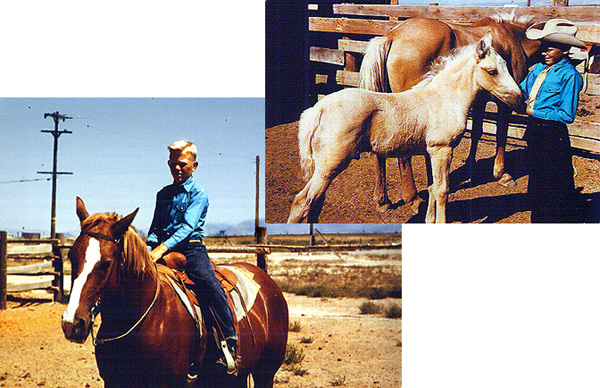
|
The desert was full of life ... jackrabbits, prairie dogs, snakes, lizards, and horned toads. We often took our 22 rifles out to hunt rabbits and prairie dogs. Not too much success, as I recall, but great fun. Dad bought me a shotgun, a 12-guage automatic, Remington Sportsman 58. We went out bird hunting a few times. Dad was a good shot and did well ... I had some nice walks and used up some ammo. We also had the run of the base, riding our bikes all over (now a 3-speed Phillips racer). We would jump for hours on end on the trampoline at the base gym. For swimming, however, we had to ride the bus into town. A nickel or dime would buy a whole handful of candy.
Dad was a member of the NRA, and Linda and I joined the JNRA. Every week we would trek off to the indoor range for practice. Dad had two 22 caliber target rifles. Linda's was a bit larger and heavier than mine, and though I was a fair shot, she was always just a bit better. We worked our way up, getting all the medals from the prone position up through the standing position. In each position you had to be able to shoot increasingly higher scores in order to qualify for the various skill levels, Marksman, Sharpshooter, Expert, etc.
The summers in Mountain Home were long and went by slowly, just as summers should for kids. We lived in what was called Brick Quarters, a collection of 2-story brick duplexes, all identical, with no fences around the yards, so we could ramble wherever we wanted. The neighborhood gang of kids would gather in the evenings for endless games of hide-and-seek and kick-the-can until we finally got called in for the night. Many warm nights we slept outside in sleeping bags under the stars. I got a star chart one Christmas, and learned many of the constellations.
Then it was back to Gram's house in Vancouver, as Dad spent a year commanding a small base on an ice island (T3) in the arctic ocean. This was my freshman year, but Shumway was a 3-year junior high. So we ninth-graders ruled. That is ... some did. I was still a shrimp, but managed to get through the year unscathed.
Upon Dad's return, he was assigned to Fairchild Air Force Base, near Spokane, Washington. These were my sophomore and junior years. We bussed into town to North Central High. I have no fond memories of Fairchild. Neither the base nor the area held any attractions. I started wrestling, and made the varsity team, but didn't win a match ... not one. I was still a shrimp, wrestling in the 112 and 120 lb. weight classes. Dad joined the base MARS club (Military Amateur Radio Society) and was elected President. He took a serious interest in it and soon qualified for his Operator's License. With a surplus receiver and transmitter, he was soon on the air. I dabbled at it, and learned Morse code, but didn't go any farther than that.
While at Fairchild, Dad decided to take retirement, with 23 years served. We traveled around the northwest looking at various properties. Finally a small farm in Cove, Oregon caught his eye. We spent the summer before my senior year on the farm, staying in a small cabin on the place. No indoor bathroom. We used the nearby outhouse. Dad commuted on the weekends from Fairchild until he retired. Then we all moved into the farm house.
My senior year was at Cove High School. Fifty students. The teachers at Cove were good, but I needed trigonometry which wasn't offered, so they accommodated me by letting me learn it by myself (sitting in the furnace room), with the Business Law teacher giving assignments. At Cove I made the varsity football team. Not a great accomplishment, as so did every other boy in school, including the one who had had polio as a child, and walked with a limp. We played 8-man ball. At 135 lbs., I was of average weight for our school. We never won a game. Eight of us graduated that year. I shared the honor of being class valedictorian with Mary Jane Connelly, a short, cute blond that I had a secret interest in. Unfortunately, not only was I quite shy, but Mary Jane had a boyfriend from Union, a bigger neighboring town, who was a star athlete, and had a reputation as a scrapper. Nobody messed with Sonny Johnson. Eventually they married.
At Cove I learned what work was all about. I learned to mow, rake, and bale hay, build fences, brand cattle, and all the myriad other tasks that farmers and ranchers face daily. Dad imported some Welsh Mountain Ponies from Wales, and soon we had quite a herd of ponies. He also raised beef cattle and had a large cherry orchard. Dad had a hired hand by the name of Frankie Brothers. Frankie was raised around cattle and horses and had worked with them all his life. Frankie was a good friend, and taught me a lot. One of my fondest memories of my time in Cove was the round-up. Dad had leased 1,000 acres of timberland in the mountains across the valley, and had been grazing several hundred head of cattle there over the summer. In the fall, Frankie and I on our horses and our two dogs had the job of rounding up these cattle, wild from a whole summer of roaming the mountains. The dogs did the work. Both were good stock dogs. Our dog, Shep, had great herding instincts from the time he was a pup, and seemed to be able to read my mind. I, of course, didn't teach him anything, because I didn't know anything about working dogs. Shep would dive into a brushy draw and moments later, cattle would explode out the other side, with Shep on their heels. By evening, we had all the cattle corralled and ready to load.
After graduation I attended Oregon State University in Corvallis. I had decided to major in Physics, as I enjoyed it, and it was said to pay well. I graduated in 1966. These were the infamous 60's ... drugs, free-love, and Vietnam war protests. I proceeded through four years at OSU pretty much oblivious to it all, and spent my summers working for Dad on the farm. After one term in a rooming house, I joined a co-op, Hawthorne Manor. A co-op, short for cooperative living, is somewhat like a poor man's fraternity, in that the students do everything but the cooking, in exchange for a low cost of living. I paid $60 per month. My last year there, as General Manager, I lived for free. My senior year, Dad bought me a car (I didn't get any pay working on the farm), a sleek black '61 Chevy Belaire, and I moved out into an apartment with three friends. My friend and roommate John Prescott, and his wild cousin, Irish, introduced me to hopping freight trains, and we made a few short trips on weekends. Also, an acquaintance got me interested in sky diving, and I made a few jumps my senior year.
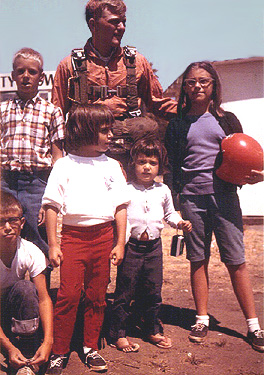
|
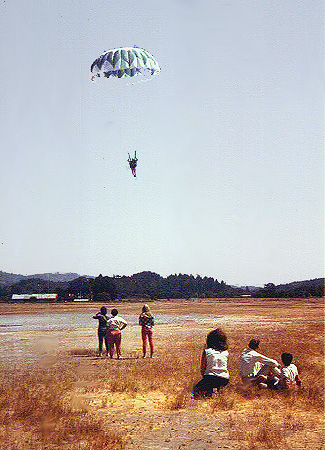
|
I decided to go to graduate school and was accepted at the University of Arizona in Tucson. Meanwhile, I applied for a summer job at NASA's Ames Research Center at Moffett Field, California. Though I really didn't accomplish anything significant, I enjoyed the job and the California lifestyle. I continued sky diving, but had to drive way up north of the Bay to the Calistoga Valley, and it was much more expensive than jumping with the OSU club. Also these were hard-core sky divers, way ahead of me, had all the latest custom gear, and devoted most of their life to it. With my ancient converted military chute, and just a few jumps, I really didn't fit in. However, these trips did allow me to spend some time with, and get to know, Uncle Spence's family, who lived just across the Golden Gate Bridge. Late that summer, I drove north to Mt. Shasta where I met John Prescott, Irish, and some friends of theirs, who had driven down from Oregon. We drove around to the east side of the mountain, and spent the night camping just at the timber line. The next morning, with no planned route, homemade ice axes, and one pair of crampons between us (mine), we climbed straight up to the top, 11 hours of climbing. Since dusk was approaching, we literally ran down the other side, where there was a fairly well established trail down Avalanche Gulch. God looks out for the ignorant!
Because I really didn't know anyone to share an apartment with, at the University of Arizona, for the first time, I lived in a dorm. Scholastically, it was an uneventful year. I worked part time as a teaching assistant, teaching physical science to elementary education majors. I learned two things from this. First, I for sure did not ever want to teach for a living. Second, heaven help the poor children that were going to be taught by these students, most of whom, with few notable exceptions, made little effort to learn what I was teaching. I didn't sky dive at the U of A, but bought a motorcycle, an old 1957 BSA Goldstar 500cc single. I spent many enjoyable hours riding with friends through the Arizona desert ... and a few non-enjoyable days in the University hospital, with a shoulder separation after a bad spill while hill-climbing.
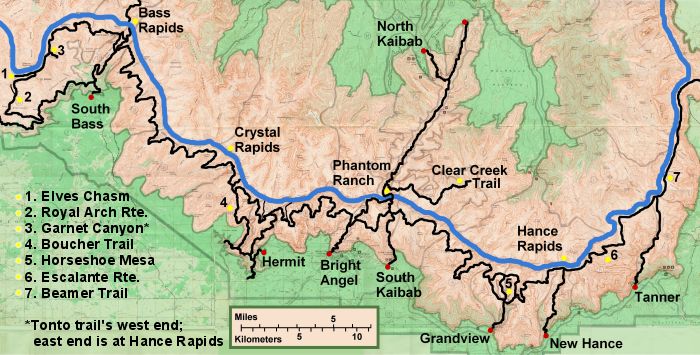
|
While in Tucson, I also was introduced to the Grand Canyon, and took the first of many hikes into the canyon ... one of my favorite things to do. During my years in Arizona I've hiked:
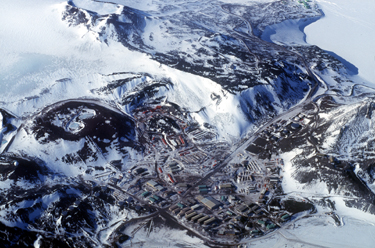
|
One day I spotted a letter posted on the Physics Department bulletin board, soliciting applicants for manning remote cosmic ray research stations for the Franklin Institute. This caught my interest, so I applied. To my surprise, I was accepted, and headed to Swarthmore, Pennsylvania to be trained during the summer at the Bartol Research Foundation, located on the campus of Swarthmore College, then under the direction of Dr. Martin A. Pomerantz . There were three of us training, one for the South Pole Station, one for a station in Greenland in the Arctic, and myself, heading for McMurdo Station in the Antarctic. I arrived at McMurdo Station, courtesy of an Air Force C121 flight from New Zealand, on Halloween, 1967. After dropping off my bags, I joined the Halloween party then in progress at the Officer's Club. (The first of many parties held at the Club.) The impact of being in the Antarctic finally hit me when I walked out of the club around 1:00 A.M. in full sunlight, with a spectacular view of the distant Royal Society Range across the still frozen Ross Sea.
My job was to maintain the neutron monitors and meson telescopes (detectors), which were used to count various particles resulting from the collision of cosmic rays with the upper atmosphere. The "Cosray" lab was in a separate building on a bluff about a mile outside the main area of McMurdo Station, on the opposite side of the penninsula on which McMurdo is located. It is on the road that eventually leads to Williams Field, where our incoming flight had landed, about a half mile before you reach Scott Base, the New Zealand base. After my predecessor completed my training and left for home, I stayed at Cosray until the summer rush was over, then moved into the USARP chalet where all the scientific staff were housed who were remaining over the winter. When I first arrived and the following summer, while it was still light during the normal daytime, I walked the mile to McMurdo, but during the winter I had the use of a Dodge PowerWagon truck. to commute. I also cared for the Forward Scatter transmitter located in a small building in McMurdo itself. I transmitted a signal that bounced off the ionisphere and was received at Vostok station, the Russian base. In turn, at Cosray I received a signal transmitted from Byrd Station that was bounced off the ionisphere and back to McMurdo.
Apart from my scientific duties, while at McMurdo I learned to ski, practicing using the rope tow lift the New Zealanders had set up; skiied behind a snowmobile through the frozen ice pressure waves along the coast of the island near the New Zealand base; had a ride on the New Zealand dog sled across the ice out to White Island; learned some Russian songs from our Russian exchange scientist, Boris Lopatin; won second prize in a chess tournament (Boris won first prize, of course); took a helicopter flight to the dry valleys across the Ross Sea, where Boris was doing geologic research; hopped a C130 flight to Vostok station (Russian) on a diplomatic visit, where I met the operator of the Forward Scatter receiving station; rode snowmobiles to the Emperor Penguin rookery on the other end of Ross Island; attended many parties; played a lot of poker; and started studying for my Master's Degree exams. I departed the Antarctic in mid-November, 1968, after training my replacement. After 6 weeks of travel and R&R in New Zealand, I returned home just in time to spend Christmas in Cove with the family.
Many years later I learned, quite by accident, that many of the earlier scientific staff were honored by naming Antarctic geographic features after them. Mine was Nims Peak, a sharp rock peak in Victoria Land, about 3 miles NW of Mount Weihaupt, in the Outback Nunataks. (A nunatak, from Inuit nunataq, is an exposed, often rocky element of a ridge, mountain, or peak not covered with ice or snow within, or at the edge of, an ice field or glacier. The term is typically used in areas where a permanent ice sheet is present. Nunataks present readily identifiable landmark reference points in glaciers or ice caps and are often named.) Nims Peak is nearly 7,000 feet high, but it doesn't appear this large, as it is just protuding through an ice sheet that is nearly as thick.
So ... now the Nims family has their own mountain. How about that!
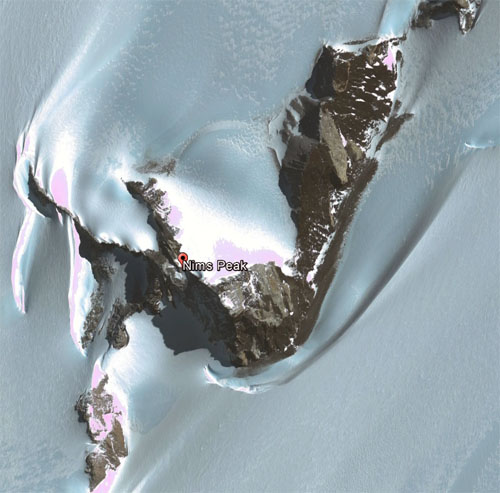
|
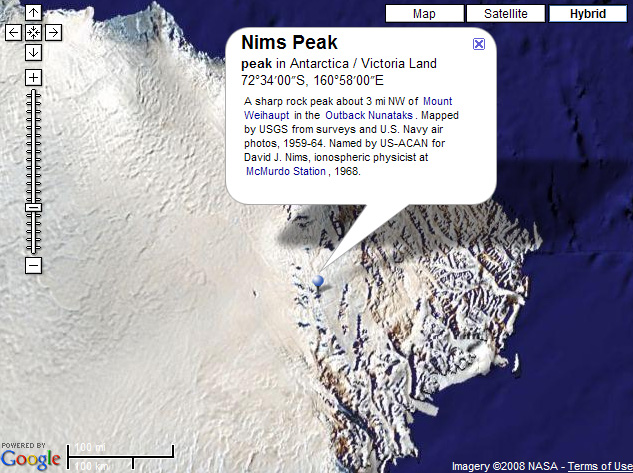 |
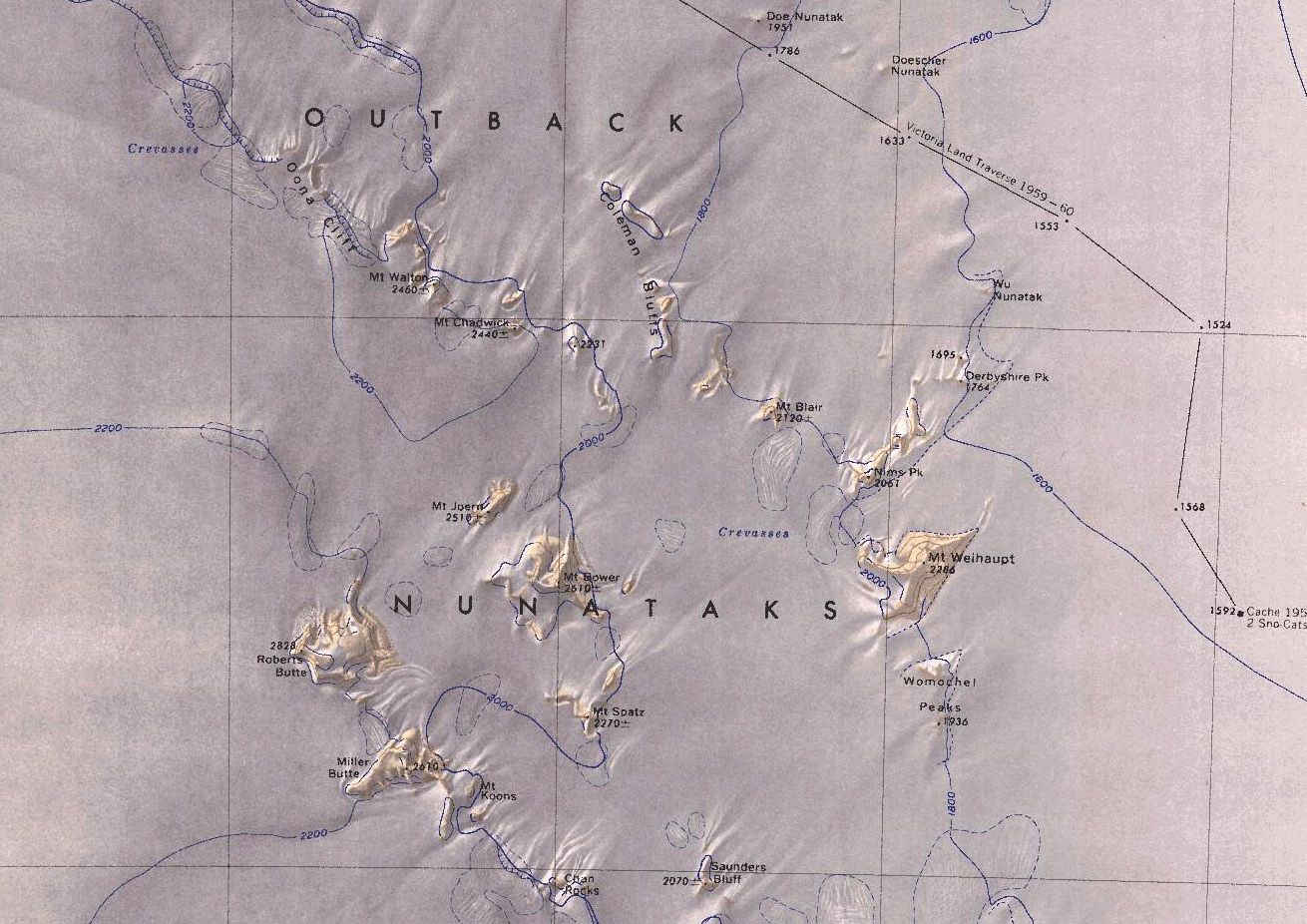
|
Returning to graduate school for the winter quarter, I was surprised to learn that Uncle Sam did not intend to give me back my student deferment. As I had left school for a year, they reclassified me 1-A, making me prime meat for the Vietnam War, still raging. I immediately appealed this reclassification, hoping that it would drag on until I graduated and had a chance at an occupational deferment. I only needed one semester to finish my Master's degree. It went by quickly. I was sharing an apartment with a friend, John Covan, and working part-time as a research assistant. It seemed my strategy was working as the term ended. I had my diploma, I had accepted a job with Goodyear Aerospace in Phoenix, and I would be working on military programs. However, the Friday before I started work, I received my letter of induction ... I had been drafted! Resigned to this twist of fate, on Monday I went to the personnel office at Goodyear and told the Human Resources Manager that I was sorry, but I was going to have to get on the bus for boot camp. He told me he might be able to do something, and asked me to go ahead and start work. Then he got on the phone with Oregon's Director of Selective Service. After a few days of conversations, I was told I could continue working at Goodyear. A good thing, or this story might be much shorter ... and have a different ending.
At Goodyear, I joined the optical design team working on an optical correlator for synthetic aperture imaging radar. In layman's language, this was a special kind of optical system that would convert raw airborne imaging radar data films into radar images of the terrain. I was working with an electrical engineer by the name of Jim Wegener, who became a good friend and we later shared an apartment. Jim had gone to school at Montana State University in Bozeman, and introduced me to Carol Leistiko, a school chum of his who was also working in Phoenix. Carol and I started dating and enjoyed spending time together. We still do, as we were married the following year and have enjoyed a happy married life ever since. This also is the subject of another story. I'll leave you with the knowlege that I soon traded my motorcycle for a color TV and made a hammock out of my parachute. Marriage is a life-changing event. Must have something to do with kids!